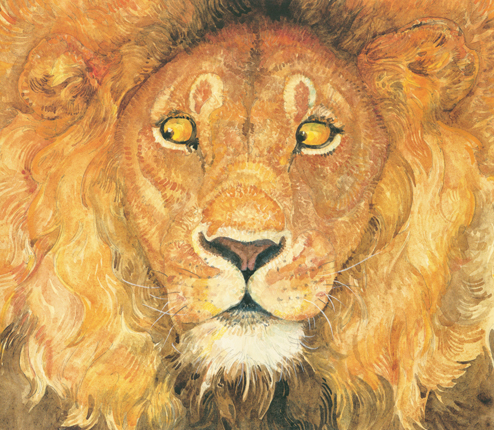| Lion & the mouse | ||
| Price: $23.78 | ||
Summary:
In this wordless retelling of an Aesop fable, an adventuresome mouse proves that even small creatures are capable of great deeds when he rescues the King of the Jungle.
| Added Entry - Personal Name: | Aesop |
| Illustrator: | Pinkney, Jerry |
Video Preview:
Awards:
Caldecott Medal, 2010
Common Core Standards
Grade K → Reading → RL Literature → Wordless Books
Grade K → Reading → RL Literature → Caldecott Medal
CC Maps Recommended Works Gde K-5
Grade K → Reading → RL Literature → K.RL Key Ideas & Details
Grade K → Reading → RL Literature → K.RL Craft & Structure
Grade K → Reading → RL Literature → K.RL Range of Reading & Level of Text Complexity
Grade K → Reading → RL Literature → K.RL Integration of Knowledge & Ideas
Reviews:
Kirkus Reviews (+) (08/01/09)
School Library Journal (02/01/17)
Booklist (+) (07/01/09)
The Bulletin of the Center for Children's Books (11/09)
The Hornbook (+) (11/09)
Full Text Reviews:
Booklist - 07/01/2009 *Starred Review* The intricate lion’s face that crowds the cover of Pinkney’s latest folktale adaptation is unaccompanied by any title or credits, and that is entirely appropriate—there are no words inside, either. Through illustration alone Pinkney relates the well-known Aesop fable of the mouse who is captured by a lion, only to be unexpectedly released. Then, when the lion finds himself trapped by hunters, it is the mouse who rescues him by gnawing through the twine. Pinkney bends his no-word rule a bit with a few noises that are worked into the art (“Screeeech” when an owl dives; “Putt-Putt-Putt” when the hunters’ jeep arrives), but these transgressions will only encourage young listeners to get involved with read-along sessions. And involved they will be—how could they not get drawn into watercolors of such detail and splendor? Pinkney’s soft, multihued strokes make everything in the jungle seem alive, right down to the rocks, as he bleeds color to indicate movement, for instance, when the lion falls free from the net. His luxuriant use of close-ups humanizes his animal characters without idealizing them, and that’s no mean feat. In a closing artist’s note, Pinkney talks about his choice to forgo text. - Copyright 2009 Booklist.
School Library Journal - 09/01/2009 PreS-Gr 3— This story starts on the cover with the glorious, golden countenance of a lion. No text is necessary to communicate the title: the direction of the beast's gaze and the conflicted expression on his tightly cropped face compel readers to turn the book over, where a mouse, almost filling the vertical space, glances back. The endpapers and artist's note place these creatures among the animal families of the African Serengeti. Each spread contributes something new in this nearly wordless narrative, including the title opening, on which the watchful rodent pauses, resting in one of the large footprints that marches across the gutter. In some scenes, Pinkney's luminous art, rendered in watercolor and colored pencil, suggests a natural harmony, as when the cool blues of the sky are mirrored in the rocks and acacia tree. In other compositions, a cream-colored background focuses attention on the exquisitely detailed and nuanced forms of the two main characters. Varied perspectives and the judicious use of panels create interest and indicate time. Sounds are used sparingly and purposefully—an owl's hoot to hint at offstage danger or an anguished roar to alert the mouse of the lion's entrapment. Contrast this version with Pinkney's traditional treatment of the same story (complete with moral) in Aesop's Fables (North-South, 2000). The ambiguity that results from the lack of words in this version allows for a slower, subtle, and ultimately more satisfying read. Moments of humor and affection complement the drama. A classic tale from a consummate artist.—Wendy Lukehart, Washington DC Public Library - Copyright 2009 Publishers Weekly, Library Journal and/or School Library Journal used with permission.
Bulletin for the Center... - 11/01/2009 Most adults know this famous fable, wherein a mouse caught by a lion begs for its freedom with the promise of a return favor, which consists of gnawing the lion free when he’s fettered by manmade ropes; here it gets a dramatic wordless (save for animal noises) treatment in Pinkney’s dramatic full-bleed watercolor illustrations. The textless rendition is an interesting approach, forefronting the nonverbal animal life and also allowing young viewers to make up their own captions. Pinkney is positively cinematic in his direction, with dramatic views emphasizing the mouse’s smallness (in the title page illustration, the little rodent pauses in the dip of the lion’s huge pawprint), relative size operating as a visual motif throughout, and a splendid suspenseful reveal introducing the lion in his first encounter with the mouse (fleeing a pursuing owl, the mouse scampers up a tawny hill that proves, two illustrations later, to be the lion’s quarters). Aesop tales are usually more about the morals than the animal actors; here’s a retelling that puts the animals front and center and breathes a note of furry reality into the proceedings. An illustrator’s note explains the rationale for the wordless approach. DS - Copyright 2009 The Board of Trustees of the University of Illinois.
School Library Journal - 02/01/2017 EMPATHY - Copyright 2017 Publishers Weekly, Library Journal and/or School Library Journal used with permission.



